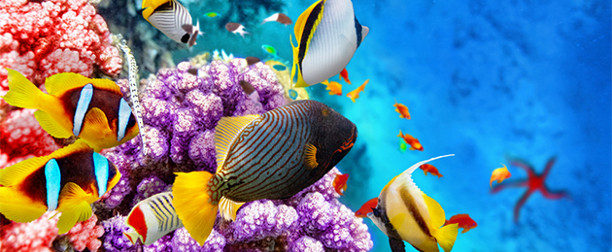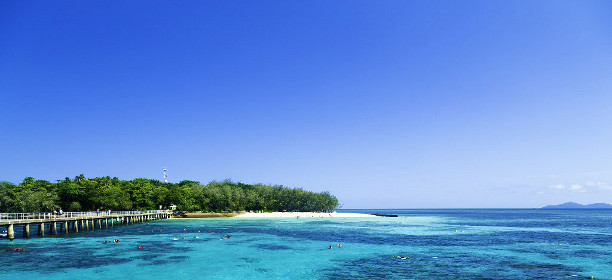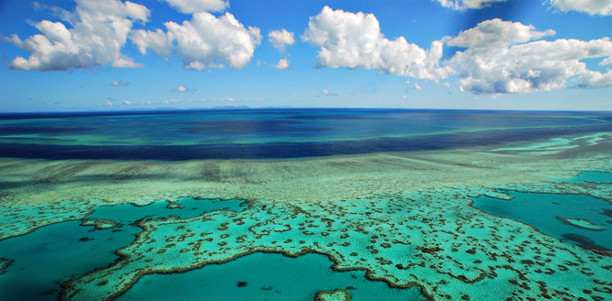
The Great Barrier Reef is the world’s largest living coral reef system spreading a whopping 2,300kms.
There are 3000 individual reefs and over 600 white sandy continental islands. To help get your head around how big this actually is, it has roughly the same land area as Italy or Germany or even Japan.
Situated off the coast of Queensland, the reef is home to more than 2000 types of fish, sharks, turtles, dolphins and rays and boasts a staggering 600 different species of coral. Now that’s a lot of snorkelling!
It is listed as a world heritage site and is one of the seven wonders of the world. It’s the only living thing that can be seen from space and even trumps the Great Wall of China.
Where to Stay
With the reef stretching over such a vast area, one of the most common questions I hear is where to stay.
The answer depends on what sort of experience you want, touristy, secluded, intimate or family friendly. Here are a few of the best areas to stay in.
-
Cairns
Cairns is the place to stay if you want to be in the middle of everything the Reef has to offer. Often referred to as the Gateway to the Great Barrier Reef, here you will find a multitude of tour operators to suit all budgets as well as resorts and hotels.
-
Townsville
The unofficial capital of North Queensland, Townsville is the place to go if you want the full Australian experience. Not only does it have some of the best diving spots, but it also offers lush rainforests as well as the historic outback. A perfect place for the adventure seekers.
-
Arlie Beach
Once known to be a backpackers paradise, Arlie Beach is also the gateway to the famous Whitsunday Islands. Here you will find a more relaxed way of life away from the big touristy spots. They offer some fantastic island hopping tours and have top notch snorkelling and fishing spots.
-
Port Douglas
The ritzy yet relaxed city of Port Douglas is perfect for the honeymooners with 5-star hotels and the glamorous 5-mile beach. Regarded as one of the most popular places to explore the northern region of the Great Barrier Reef, it is also close to the Daintree Forest, another must-see destination for travellers.
How to see the Great Barrier Reef
With such a vast area to explore, where do you start? There are a lot of options, here are some of the most popular ways to see the reef.
-
Self Snorkel
If you are only passing through Queensland and are short on time, throw the snorkel in the back of the car and go for a drive. You can either go it alone and simply snorkel off the coast or join a tour group. Tangalooma Wrecks in Moreton Island is a cool place to check out. We also love the Geoffrey Bay Snorkel Trail on Magnetic Island.
-
Day Trip
Most cities along the coast offer some great day cruises that will take you to some of the best snorkelling locations. Usually, on a day trip, they will stop at three different locations and give you about an hour at each spot. Expect to pay somewhere between $90 to $300 per person.
-
Liveaboards
A liveaboard is like your own personal floating hotel. From 2 days to 2 weeks, a liveaboard gets you away from the crowds of the day trippers to the outer parts of the reef. You get a lot more diving or snorkel time as well as the option to snorkel at night. While a little more pricey with tours starting ar $450 for two nights, they are well worth the price tag for the amazing sights you get to see.
-
Birds Eye View
If you don’t like to snorkel or get terribly seasick, another great way to see a LOT of the reef is take a scenic flight. There are many companies that offer seaplane adventures or helicopter rides. Prices start from around $300 for half an hour.
When to visit
Queensland’s weather is split between a dry season and a wet season with temperatures staying warm and sunny most of the year. The dry season starts in June and goes through until November with October being the pick of the bunch.
The wet season goes from December through until March. While the monsoonal rain doesn’t effect tour schedules a great deal, the temperatures can get quite hot and humid. Perfect for water activities, not so good for sleeping and travelling around.
You can book your flights and accommodation here today and get some of the best deals online for the Great Barrier Reef.







